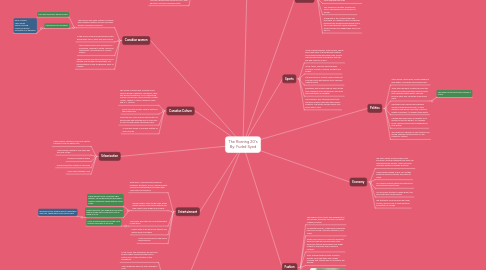The Roaring 20's By: Fudail Syed
создатель Fudail Syed - Heart Lake SS (2462)


1. Aboriginals
1.1. In the 1920’s, the Aboriginals did not have proper rights. The government was in control of all of the activities of the Aboriginals.
1.2. The Aboriginals were not even allowed to vote
1.3. Residential schools were continued even after the war
1.4. The Government was freely allowed to take away land from the Aboriginals and allowed to take away their status
1.5. The government thought that changing their lifestyles to be more like a typical christian lifestyle, would make their lives better. The government tried changing their lives by opening residential schools in churches and trying to preach christianity to them.
2. New Technologies and Inventions
2.1. The Hudson Bay Railway was opened in 1929, giving Canadians the ability to travel far distances without having to own a car
2.2. Most ares were being converted to using direct dial telephone services. Canadians were able to call other parts of the world.
2.3. The Invention of the Radio
2.4. The Airline industry was booming, allowing Canadians the ability to travel even farther distances in short periods of time
2.5. Washing machines were starting to be made
2.6. Vacuum cleaners were improved on to later become a common household item
3. Urbanization
3.1. Many farmers started to move into central Canada to look for better jobs
3.2. Many people started to lose their jobs because of this
3.3. Pollution increased largely
3.4. Animal population started to decrease
3.5. Crime rates started to rise
4. Canadian women
4.1. The Famous Five were a group of women who created a petition to have Canadian women considered “persons”
4.1.1. This was called the “persons case”
4.1.2. The famous five included:
4.1.2.1. Emily Murphy. Irene Parlby. Nellie McClung. Louise McKinney. Henrietta Muir Edwards.
4.2. In the 1920s, more and more women were being given jobs in sales than ever before.
4.3. Mary Pickford was a very big actress in Hollywood, referred to as the “American Sweetheart”. She was born in Toronto, Ontario.
4.4. Agnes MacPhail was the first woman to be elected as a member of parliament, as a representative of the “Progressive Party of Canada”
5. Entertainment
5.1. After the TV was invented, television programs started to air live, making a great source of entertainment for people who could afford a television.
5.2. People used to listen to the radio. Radio shows used to come on the station and they used to play songs and comedy.
5.2.1. There weren't many Canadian radio stations, so the government decided to create a nationally owned station called CRBC
5.2.2. Radios were still very expensive and some high end radio sets could even cost as much as a car.
5.2.2.1. Because of this, people used to make their own sets, these were called crystal sets.
5.3. Jazz music was one form of entertainment in the 1920s
5.3.1. Louis Armstrong was one of the most famous musicians at the time
5.4. People used to go the movie theatre and watch silent films there.
5.5. Musical Performances and dance performances
6. Canadian Culture
6.1. The Group of Seven was Canada’s most famous group of painters. Founded in 1920, this group consisted of: J.E.H. MacDonald, Franklin Carmichael, Frank Johnston, Arthur Lismer, Lawren S. Harris, Frederick Varley and A.Y. Jackson.
6.2. Emily Carr was another famous painter in the Roaring 20s.
6.3. After the War, many poems were written to help people deal with the loss of loved one or even to help people remember them.
6.4. “In Flanders Fields” is a people written by John McCrae.
7. Politics
7.1. After Wilfrid Laurier died, Canada needed a new leader. MacKenzie King was elected.
7.2. There was new party created because the people of Ontario wanted a political party that supported their wants. The new political party was called the Progressive Party.
7.2.1. The leader of this party was Thomas A. Crerar.

